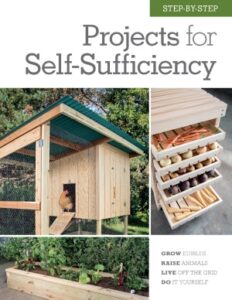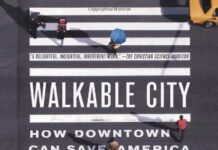| Book Name: | Step-By-Step Projects for Self-Sufficiency |
| Category: | Architecture Books |
| Language: | English |
| Format: | |
| Free Download: | Available |
Step-By-Step Projects for Self-Sufficiency | PDF Free Download.
| Book Details : | |
|---|---|
| Language | English |
| Pages | 335 |
| Format | |
| Size | 85.7 MB |
Step-By-Step Projects for Self-Sufficiency

Book Description:
Get ready to be self-sufficient. Whether tackling the garden, raising animals, learning more about alternative energy, or bettering your storage and preservation, Step-by-Step Projects for Self-Sufficiency is the perfect starting point.
Step-by-step instructions and photos will guide you through how to make over 60 complete projects. After all, DIY projects are more fun (and generally easier) when you approach them with helpful aides and tools you made yourself.
Projects in this new volume include:
-A portable chicken ark
-Two types of beehives
-Solar cookers
-Firewood storage
-A potato growing box
-Hoophouses and greenhouses
-Raised planting beds
-Rainbarrels
-A cider press
-Compost bins
-Drying racks
With its clear plan drawings, precise instructions and detailed photos, Step-by-step Projects for Self Sufficiency makes DIY easier than ever.
Projects for Self-Sufficiency Contents
Section 1: Chickens & Other Creatures
- Chicken Ark
- Chicken Coop
- Brooder Box
- Large Farm Animals
- Top-Bar Beehive
- Traditional Beehive
Section 2: Nourishing Your Garden
- Compost Bin
- Two-Bin Composter
- Basement Vermiculture Bin
- Soil Sifter
- Collecting Rainwater
- Channeling Rainwater
- Sub-Irrigated Planter
Section 3: Garden Projects
- Starting & Transplanting Seedlings
- Potato-Growing Box
- Octagon Strawberry Planter & Cover
- Vertical Planter
- Clothesline Trellis
- Teepee Trellis
- Raised Bed With Removable Trellis
- Pallet Planter
- Raised Beds
- Container Gardening
- Cold Frame
- Jumbo Cold Frame
- Planting Trees
Section 4: Food Preparation & Preservation
- Preserving Your Bounty
- Solar Dryer
- Solar Fruit Dryer
- Herb-Drying Rack
- Root Vegetable Rack
- Root Cellar
- Cider Press
- Solar Oven
Section 5: Homestead Amenities
- Firewood Shelter
- Frame Loom
- Solar Still
- Manual Laundry Washer
- Solar Heat
- Wine Racks For Winemakers
Section 6: Outbuildings & Fences
- Greenhouse
- Hoophouse
- Metal Kit Shed
- Pole Barn
- Post-And-Board Fence
- Split-Rail Fence
- Chain-Link Fence
Introduction to Step-By-Step Projects for Self-Sufficiency PDF
Living a more independent lifestyle is a rewarding goal. By learning to do more things yourself, you gain control of the how and when and what of modern life. The projects in this book are designed to help you reach the goal of self-sufficient living.
The best part is that you don’t need to sell your townhome and move to 80 acres in the mountains to make use of these projects. Pick off a few here and there, and you can participate in the self-sufficient way of being without making the sacrifices required when living off the grid.
Building a greenhouse is a great way for gardeners to jumpstart the growing season, or to introduce new, sensitive plants to your garden. See page 280.
The homestead maylook very different today than in the pioneer days. But we can compensate for what we lack in acreage with creativity. Growing edibles in containers on a balcony is just one way to pursue your self-sufficient goals in an urban setting.
Home artslike weaving may seem obsolete, but participation in them is growing. If you really want to let your self-sufficiency flag fly, don’t just learn to weave: build your own frame loom (see pages 236 to 241).
Hard or soft, apple or pear, homemade cider is pure goodness. But you can’t make it efficiently without a cider press. See pages 214 to 219 for an easy, DIY press you can make.
Why aspire to self-sufficiency? Because of the pace of modern life can be overwhelming. All too often, the amazing technology that was supposed to free us and make life better and better instead becomes a drain on our money, time, and joy.
As we’ve tried to improve our lives through progress and efficiency, we have ironically moved further and further from many of the things that make life healthy, rewarding, and fulfilling. It’s just a matter of cause and effect.
Medical advances that allow for gene therapy are used to create GMO foods of unproven safety. Ever-ready energy supply has ensured that our lives are more comfortable and convenient than ever before; but our environment pays for that convenience in the fallout from fracking, the pollution of coal-fired power plants, and the occasional devastating oil spill.
All the while, modern life seems to demand that we move faster, do more, make more, and consume more.
Along the way, we’ve become less able to do for ourselves, and more in the habit of buying everything we need regardless of the environmental and personal consequences. And make no mistake, there are consequences.
As we continue to fill landfills at an alarming rate, see our water tables and well water increasingly become contaminated, and learn more about how corporate farming is creating a less diverse food-supply chain, the global and environmental benefits of what’s come to be known as “self-sufficient living” become more relevant and more apparent.
By saving water, raising food that doesn’t involve long-distance transport (and all the fuel and pollution that transportation entails), and finding new ways to create what we need using only the energy in our bodies, we’re not only helping ourselves, we’re helping the world.
Those upsides are attracting growing numbers of people to a self-sufficient lifestyle. The fact that you’re reading this book means that chances are, you’re one of those people.
Slowly but surely, we’re learning that quantity, speed, and convenience do not always equal quality, wholesomeness, and satisfaction.
People across the country are realizing that highly processed food, produced and packaged on an industrial level, is often not as truly good tasting or as good for you as simpler food grown in your own backyard.
People are reconnecting with animal husbandry, from raising two or three chickens to a small herd of goats.
They are finding the pleasure in working with living things that create resources, such as food and fertilizer and rediscovering the simple joy of hand-woven textiles made on a loom they built themselves.
They are realizing that there is a gentler way to live on the ecosystems of which we are so much apart. On a more pragmatic level, they are saving money with what they grow and produce and what they no longer need to buy
Solar panels that collect and heat air to warm cold spaces in your home are mechanisms you can build yourself and duct into your home’s existing ductwork. Learn how on page 254.
The best resources are the ones you already own. Reusing or repurposing stuff you no longer need takes some creativity, but ultimately it fills needs, not landfills. For example, this discarded dressing table found a new life as a vanity cabinet in a self-sufficient homeowner’s bathroom.
But more than that, they are choosing to live better, more rewarding lives. They are rediscovering the simple pleasure of creating something of worth with their own hands, reconnecting with the garden and finding a sense of craftsmanship and purpose in everyday life.
These people are creating new traditions for their families and getting reacquainted with timeworn, valuable experiences, and skills.
This is all part of choosing a richer life. Thankfully, this movement is not an all-or-nothing proposition. Self-sufficiency doesn’t necessarily mean that you need to move completely off the grid and live without modern conveniences or technology.
People still need to go to work, attend family events, commute, and spend some downtime doing nothing (or whatever they enjoy doing). Other people don’t have the skills or inclination to build, much less use, something like a loom. All that’s okay.
Maybe you don’t want to raise chickens, but building a cold frame or adding a double-bin composter is more your speed. You can pick and choose; there’s no evil in using the computer or watching a ball game on your big-screen TV.
Self-sufficiency isn’t about living in a cave. It’s about taking steps to do for yourself, to move back toward simpler, more fulfilling practices in daily life, and to help the environment one step at a time. It’s about living healthy and creating a healthier world.
In short, it’s about changing your life and the world around you in common-sense, achievable, and positive ways.
On that note, you should be realistic when you choose which projects in this book you’d like to tackle. If you’re up for doing all of them, good for you. But it’s just as good if you only feel comfortable tackling a few of them right now—or even just one.
You can always do more later, and any step you take toward self-sufficiency is a step in the right direction. Even the most modest action is better than overreaching, getting burned out, and giving up on the notion of self-sufficiency altogether.
To give you as much choice as possible, we’ve included a wide range of projects that can help you lead a self-sufficient life. Learn about composting, planting, raising animals, preparing and drying food, constructing sheds and greenhouses, building fences—even assembling a wine cellar for your wines.
The projects range from simple to involved, but none of them require anything more than moderate DIY and woodworking skills.
We’ve tried to make the simple life as simple as possible to create. No matter how much self-sufficiency you decide to implement in your life, you’ll change your life and the world.
Do a little or a lot, and you can still feel satisfied that you’re doing something. It may seem like a drop in the bucket, but that’s exactly how buckets are filled.
Raising city chickens is a booming business for today’s urban homesteaders and hobby farmers working in a more rural setting. But keep in mind that for most chicken farmers, it’s all about the eggs. We show you how to build your own coop (page 28) and the brooder box (page 36).
Splitting firewood is a great exercise and a good way to work off stress, but where will you store it? See pages 230 to 235 for a compact firewood shelter that’s also attractive.
The Self-Sufficient Lifestyle
Self-sufficient living is a highly complementary practice—once you begin, you’ll find that many parts of your home are connected and that multiple systems of self-sufficiency contribute to one another, often corresponding with the earth’s natural cycles.
Because of this interconnectedness, many of the projects in this book will naturally lead you to more and more projects that will help you maximize your self-sufficiency work.
For example, if you start a garden, the fruits and vegetables you grow will provide waste that will transform into the compost that will nurture next year’s bounty.
Setting up a rainwater collection system reduces your reliance on public utilities, and the fresh, soft water will also help your plants grow healthy.
The hens you are raising for their eggs control garden pests and provide free fertilizer. At the end of the growing season, you’ll likely be overwhelmed with vegetables and will need to find a means to store and preserve them—perhaps a basement root cellar could be a good option.
And, by growing organic vegetables nurtured by compost and animal manure, you create a pesticide-free habitat for honeybees to prosper, while they, in turn, pollinate the plant life. That said, you do not need to take on all the projects in this book at once.
Start with the projects that naturally supplement your family’s efforts toward self-sufficiency. If you already recycle, a natural next step is to build compost bins and begin composting with food and paper waste.
If you already maintain a beautiful flower garden, why not build a home for the honeybees that are already frequent visitors, allowing you to collect the honey they produce? If you already grow fruits and vegetables, why not build a solar fruit dryer or drying rack, or make a cider press if you have apples?
If you already garden, why not build a greenhouse? For the newcomer, the projects on the following pages provide multiple opportunities to create a more self-reliant lifestyle.
For the experienced self-sufficient homeowner, the step-by-step projects included here will provide you with the means to expand and streamline your efforts.
Download Step-by-step projects for self-sufficiency: grow edibles, raise animals, live off the grid, DIY PDF
Author(s): Editors of Cool Springs Press
Publisher: Cool Springs Press, Year: 2017
ISBN: 978-1-59186-688-6
Download Step-By-Step Projects for Self-Sufficiency in PDF Format For Free.









![[PDF] Draw Buildings and Cities in 15 Minutes Draw Buildings and Cities in 15 Minutes pdf](https://www.freepdfbook.com/wp-content/uploads/2021/06/Draw-Buildings-and-Cities-in-15-Minutes-218x150.jpg)








![[PDF] Digital Image Processing An Algorithmic Introduction Using Java Digital Image Processing An Algorithmic Introduction Using Java](https://www.freepdfbook.com/wp-content/uploads/2022/06/Digital-Image-Processing-An-Algorithmic-Introduction-Using-Java.jpg)




![[PDF] 43 Years JEE ADVANCED + JEE MAIN Chapterwise & Topicwise Solved Papers 43 Years JEE ADVANCED (1978-2020) + JEE MAIN Chapterwise & Topicwise Solved Papers Physics PDF](https://www.freepdfbook.com/wp-content/uploads/2022/03/43-Years-JEE-ADVANCED-1978-2020.jpg)

![[PDF] Problems in Physical Chemistry for JEE (Main & Advanced) Problems in Physical Chemistry for JEE (Main & Advanced) Free PDF Book Download](https://www.freepdfbook.com/wp-content/uploads/2022/03/Problems-in-Physical-Chemistry-for-JEE-Main-Advanced.jpg)
![[PDF] Engineering Physics (McGraw Hill)](https://www.freepdfbook.com/wp-content/uploads/2021/05/bafc8c2685bb6823a9c56134f7fba5df.jpeg)

![[PDF] Engineering Chemistry By Shashi Chawla](https://www.freepdfbook.com/wp-content/uploads/2022/05/Theory-And-Practicals-of-Engineering-Chemistry-By-Shashi-Chawla-free-pdf-book.jpeg)
![[PDF] Chemistry: An Introduction to Organic, Inorganic & Physical Chemistry Chemistry: An Introduction to Organic, Inorganic & Physical Chemistry](https://www.freepdfbook.com/wp-content/uploads/2022/04/Chemistry-An-Introduction-to-Organic-Inorganic-Physical-Chemistry.jpg)
![[PDF] Essentials of Physical Chemistry Essentials of Physical Chemistry Free PDF Book by Bahl](https://www.freepdfbook.com/wp-content/uploads/2022/04/Essentials-of-Physical-Chemistry-bahl.jpg)
![[PDF] Biological control of plant-parasitic nematodes: soil ecosystem management in sustainable agriculture Biological control of plant-parasitic nematodes: soil ecosystem management in sustainable agriculture](https://www.freepdfbook.com/wp-content/uploads/2022/05/Biological-control-of-plant-parasitic-nematodes-soil-ecosystem-management-in-sustainable-agriculture.jpg)
![[PDF] Human Anatomy: Color Atlas and Textbook Human Anatomy: Color Atlas and Textbook Free PDF Book](https://www.freepdfbook.com/wp-content/uploads/2022/05/Human-Anatomy-Color-Atlas-and-Textbook.jpg)
![[PDF] Concepts of Biology Book [Free Download]](https://www.freepdfbook.com/wp-content/uploads/2022/05/Concepts-of-Biology.jpg)
![[PDF] Essentials of Biology [Free Download] Essentials of Biology Free PDF BOok Download](https://www.freepdfbook.com/wp-content/uploads/2022/05/Essentials-of-Biology-Free-PDF-Book-Downlaod.jpg)
![[PDF] Human Biology Book [Free Download]](https://www.freepdfbook.com/wp-content/uploads/2022/05/PDF-Human-Biology-Book-Free-Download.jpg)


